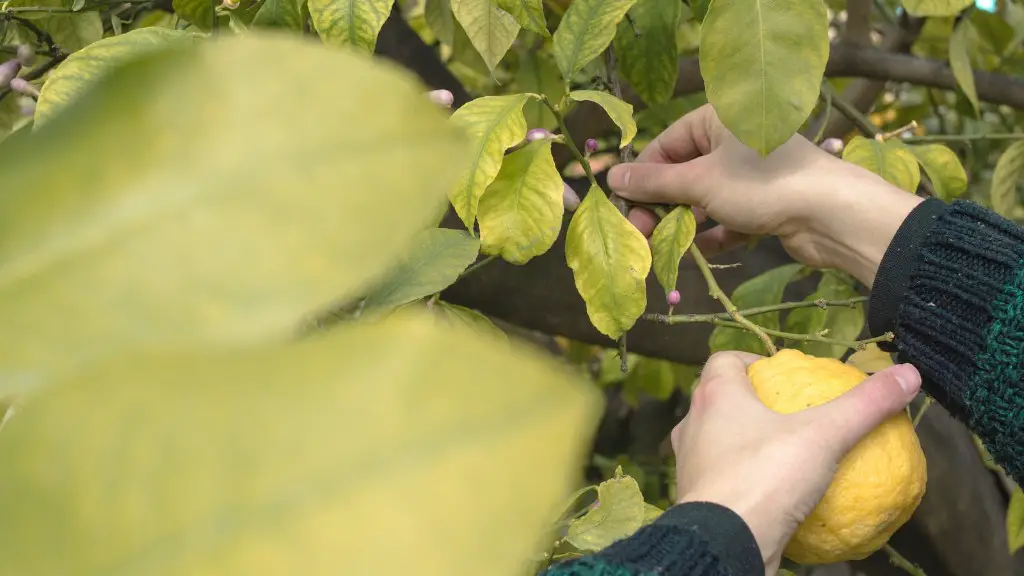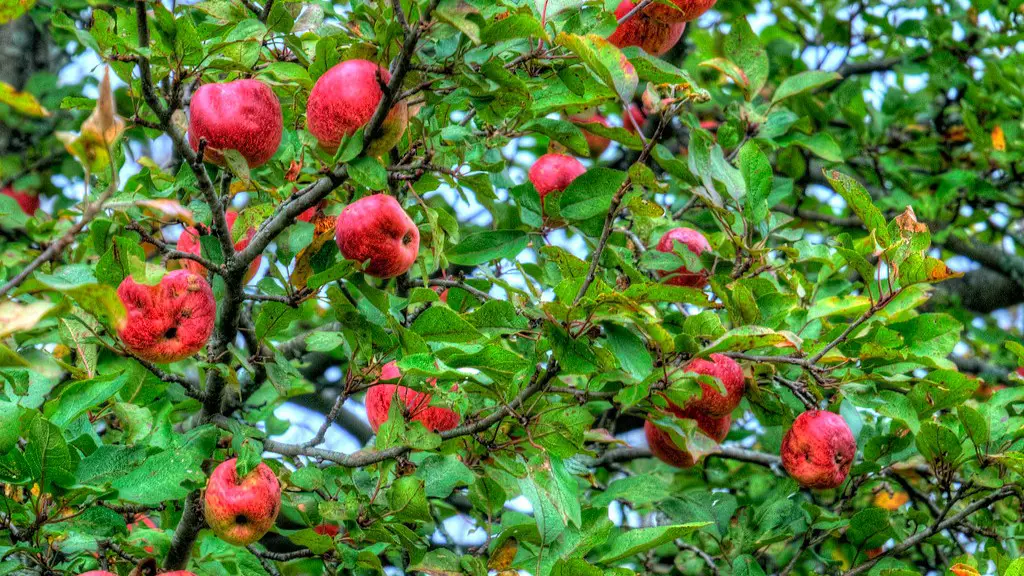1. Pruning and Trimming:
Regularly pruning and trimming your palm tree is a key part of the maintenance process. Trimming helps to reduce the palm’s larval load, thin the canopy of existing fronds and reduce the size of the crown. An established palm tree should only need pruning once every year or two, at the permit of an experienced arborist. When trimming, always wear protective clothing and eye protection, as palm fronds and fruit are quite sharp. The very best way to prune and trim a palm tree is to use a ladder and an extendable, curved pruner. This tool can help you to reach and cut off big fronds without hurting yourself or damaging the tree. It is also important to use the correct ladder to reach any tall palms, as they can be very tall and require extra caution when pruning.
2. Provide Additional Support:
When a palm tree grows too large, or has heavy fronds that are starting to droop, you may need to provide the tree with some additional support. This can be done by tying the fronds up with string or wire, or, for more serious cases, by installing a metal hook or reinforcement bars at the base of the trunk. It is important to use a metal hook or bar, as these can offer the most durability when supporting large fronds. Make sure to check your tree regularly, and use extra support as needed to ensure that your palm tree remains safe and healthy.
3. Fertilize Regularly:
Fertilizing your palm tree is an important part of the maintenance process. Generally speaking, most palm trees require light to medium levels of fertilizer in the spring and summer months, and heavier applications in the fall and winter months. It is important to use the correct type of fertilizer, as too much fertilizer can actually be harmful to your palm tree. Ensure that you read the instructions carefully before fertilizing, and always wear gloves and protective clothing when handling fertilizer.
4. Use Mulch to Help Retain Moisture:
Applying mulch can help your palm tree to retain moisture, which is important for its overall health. It is best to use mulch that is made from natural materials, such as wood chips or shredded bark. Make sure to spread the mulch around the base of the palm tree, in a layer that is approximately four to six inches deep. Be sure to water the mulch as needed, and avoid heaping the mulch directly against the trunk of the tree.
5. Control Pests and Diseases:
Pests and diseases can quickly spread amongst your palm trees, so it is important to be vigilant in monitoring your trees for signs of infestation. Check your trees regularly for signs of infestation, such as discoloration of leaves, insects, or slow growth. If you notice any of these symptoms, promptly treat the affected areas using insecticides and other treatments as needed. If you are unsure how to treat your palm tree correctly, consult an expert or local arborist.
6. Water Regularly:
Finally, it is important to water your palm tree on a regular basis. This will help to maintain adequate soil moisture and keep the roots healthy. You should water your palm trees about twice weekly during summer months, ensuring the soil is kept moist but not waterlogged. During other times of the year, reduce the amount of water you provide to your palm tree, but ensure that the soil is never dry.
7. Watch for Abnormal Growth:
When maintaining your palm trees, it is also important to watch for any abnormal growth. This can be easily done by regularly inspecting the fronds for any signs of disease or pests. Additionally, watch for any changes in the color of the leaves, as this could be an indication of health issues. If you notice anything concerning, promptly consult an expert or local arborist.
8. Monitor Soil Conditions:
It is important to regularly monitor the soil conditions around your palm trees. Ensure that the soil is of the right consistency – not too dry or too wet – and has enough nutrients, such as nitrogen and phosphate. If your soil is lacking any necessary nutrients, you can add supplements or fertilizer to help keep your palm trees healthy and thriving.
9. Plant in the Right Location:
It is important to ensure that you are planting your palm trees in a suitable location, as this can have a big impact on the tree’s overall health. Choose a location that receives adequate sunlight, is sheltered from strong winds, and has well-draining soil. Additionally, make sure to give your palm tree plenty of space to spread and grow, as too crowded of a location can lead to poor air circulation and pest infestations.
10. General Care:
Finally, there are some general care tips to keep in mind in order to maintain your palm trees. Make sure to remove any dead, diseased, or damaged fronds as soon as possible and avoid using metal tools that could damage the foliage. Additionally, keep an eye out for any signs of pests or diseases and treat them promptly if needed. Finally, don’t forget to give your palm trees some tender loving care – your palms will thank you for it!
Advanced Maintenance Tips for Palm Trees
1. Trim Roots:
Roots are very important for the overall health of your palm tree, as they help to provide the tree with additional support and absorb essential nutrients. However, it is important to prune the roots of your palm tree regularly, as dead or old roots can accumulate and become too large, which can lead to problems such as a weakened structure or an unbalanced tree. When trimming the roots of your palm tree, make sure to use the right tools and to not remove more than half of the root mass. Additionally, don’t prune more than necessary, as the roots are very important for the overall health of your tree.
2. Install Protection:
Another tip for maintaining your palm tree is to install protection from the elements such as wind, storms, and extreme temperatures. This may include installing hurricane straps or other protective hardware, or planting your palm tree in a sheltered location. Additionally, consider adding a shade cloth to protect your palm tree from the sun’s harsh rays, as too much sun can easily cause damage to the leaves.
3. Fungicides and Pesticides:
Fungicides and pesticides can be used to help protect your palm tree from major pest or disease infestations, as well as other environmental factor. Before using any fungicides or pesticides, make sure to read the labels carefully and follow the instructions exactly. Additionally, it can be beneficial to consult an expert or local arborist if you are unsure how to properly treat your palm tree.
4. Pruning with Caution:
Pruning can be a beneficial part of Palm tree maintenance, but it should always be done with caution. Make sure to avoid pruning when the tree is flowering or when the weather is too hot, as this can lead to issues such as a weakened tree structure. Additionally, never prune more than 25% of your palm tree’s total canopy.
5. Monitor Water Level:
The amount of water that your palm tree receives can have a major impact on its overall health, so it is important to monitor the water level around your tree carefully. Generally speaking, your palm tree should receive about two inches of water per week, although this may vary depending on the climate and other environmental factors. Additionally, make sure to check your soil regularly to ensure that the moisture level is sufficient.
6. Improve Soil Quality:
The quality of your soil can have a big impact on the health of your palm tree, so it is important to make sure that it is of the highest quality. Be sure to make use of soil improvement techniques such as composting, as this can help to boost the nutrients and organic matter levels in the soil. Additionally, consider adding fertilizer or supplements to the soil as needed to ensure that your palm tree is getting all the nutrients that it needs.
7. Irrigation and Misting:
Irrigation and misting are two important methods of maintaining your palm tree. Irrigation helps to provide your palm tree with the moisture it needs, while misting helps to provide the tree with essential nutrients. Additionally, both methods can help to reduce the temperature around the tree and provide a more pleasant environment. Make sure to check your palm tree regularly and adjust the misting and irrigation schedule as needed.
8. Remove Invasive Species:
Invasive species such as bugs, weeds, and other pests can quickly take over your palm tree, leading to health issues and an Unbalanced structure. It is important to keep an eye out for any signs of infestation and control it promptly as needed. To help prevent infestations, make sure to keep your area and surrounding environment free from debris or overgrown foliage.
9. Seek Professional Help:
For best results, it can be beneficial to consult an experienced arborist for help with maintaining your palm tree. An arborist can provide you with the best advice on how to properly care for your palm tree and keep it healthy. Additionally, they can also help to spot any potential health problems early and take appropriate steps to ensure the tree remains healthy and thriving.
10. general Care:
Finally, it is important to remember to provide your palm tree with general care such as regular pruning and trimming, as well as checking for pests and diseases. Additionally, monitor your tree’s water and soil levels and make sure to use the right fertilizer and other supplements as needed. With the proper care and maintenance, you can ensure that your palm tree remains healthy and vibrant for many years to come.



